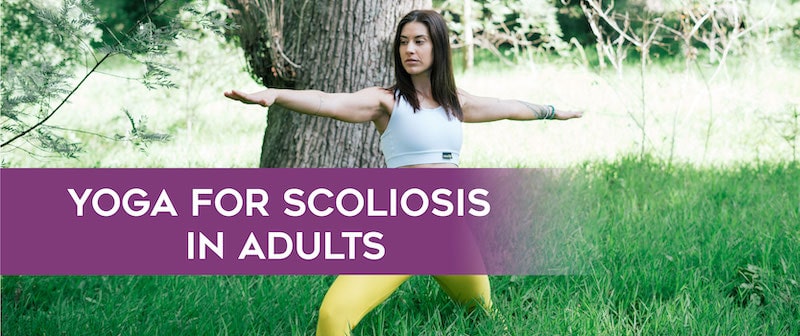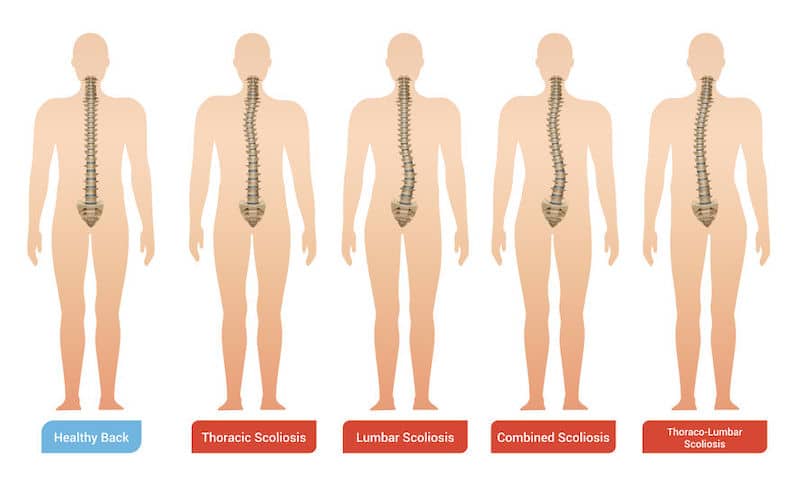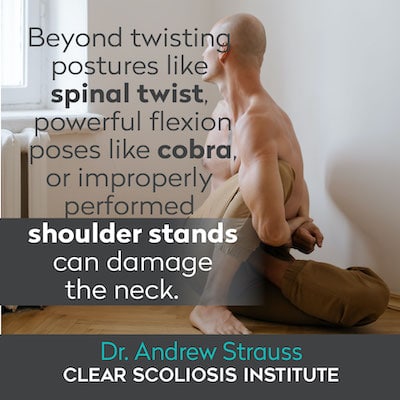
As a doctor who provides alternative noninvasive scoliosis treatment, I am frequently asked about yoga for scoliosis treatment in adults. Does it work? Is it helpful? Can using yoga for scoliosis actually treat scoliosis?
Having implemented many natural and effective forms of alternative scoliosis treatment and helped thousands of scoliosis patients worldwide, I can confidently say that while it is beneficial, it is not a complete treatment for scoliosis. I am a lifelong practitioner of yoga and continue to this day to have a one hour daily yoga practice.
In order for a yoga for scoliosis program to slow a curve’s progression or even more importantly if you seek to reduce a curve, it must be combined with scoliosis-specific professional care. When yoga for scoliosis is practiced correctly and used in combination with scoliosis-specific treatment, it works, it’s helpful, and it can help stabilize and reduce curves.
This article will discuss yoga for scoliosis with two particular types of adult scoliosis - adults with scoliosis that developed during adolescence, and adults with scoliosis that developed later on in life (degenerative scoliosis).
As with any exercise program, it is best to practice yoga for scoliosis under the guidance and direction of a healthcare professional who is trained in both scoliosis and yoga. This is my area of expertise.

Before jumping into scoliosis yoga as a treatment for scoliosis, it is important to have an understanding of scoliosis and how it affects the structure of your spine and your body.
By definition, scoliosis is an abnormal lateral curvature of the spine. This definition is, however, oversimplified. Scoliosis is actually a three-dimensional deformity of the spine and the trunk.
It is complex, sometimes confusing, and each case is unique. In my 39 years of practicing scoliosis-specific chiropractic, I have never seen two cases of scoliosis that are the same. Because of this, if you are thinking about practicing yoga for scoliosis, it is very important that you are aware of your unique scoliosis pattern and consult with a professional before you begin.
In the realm of scoliosis, you may hear people reference s-shaped curves and c-shaped curves. Distinguishing your particular type of curve and the location of your curve before practicing yoga for scoliosis is important.
When we look at the spine from the front or the back, it should be straight. This is considered healthy and normal. Earlier I referenced that scoliosis is an abnormal sideways curvature of the spine. This curvature can be located in different regions of the spine - most commonly the thoracic spine (mid and upper back) and the lumbar spine (lower back). With scoliosis, there can also be more than one curve present. The highest number of curves I have seen in a scoliotic spine is four.
Before we move on, let’s talk a little bit about the location of scoliosis.
Thoracic scoliosis involves the thoracic spine, which is the mid to upper back. Curves in this area of the spine are most commonly c-shaped curves that bend to the right - away from the heart. Curves bending to the right are known as dextroscoliosis. When a curve in this area of the spine bends to the left, towards the heart, it is known as levoscoliosis. When levoscoliosis is present in the thoracic spine, it is a red flag and an indicator that the scoliosis may be secondary to another condition or disease.
Levoscoliosis is most common in the lumbar scoliosis. With lumbar scoliosis, the scoliosis curve is located in the lower back.
When a patient’s scoliosis curve involves the mid-back and the upper portion of the lower back, it is considered a thoraco-lumbar scoliosis curve. In most cases of thoraco-lumbar scoliosis, the curve bends to the right.
S-shaped curves are present when a patient has multiple curves in their spine going towards both the right and left, making the shape of an “s” - thus the name s-shaped curve.

Once you know more about your scoliosis pattern, you can begin learning about the basics of yoga for scoliosis. Keep in mind that consulting with a healthcare professional who is trained in both yoga and scoliosis is best!
My most important piece of advice when it comes to practicing yoga for scoliosis is be careful! Like many other things, if used incorrectly, it can be damaging to your health, your body, and your spine. Yoga must be practiced with knowledge, skill, and attention. Knowing what you can and cannot do, or should and should not do, is always important when practicing yoga, but it is especially important if you have scoliosis.
Just like your scoliosis pattern is unique, your yoga for scoliosis practice should also be unique. It is best to practice yoga for scoliosis under the guidance and direction of a healthcare professional who is trained in both scoliosis and yoga. As a CLEAR-certified doctor and yoga instructor, this is my area of expertise.
There are seven poses and best practices that should be followed when practicing yoga for scoliosis. [1]
You can learn more about implementing these seven practices and why they are important in my article on Yogi Approved - Yoga for Scoliosis: 8 Ways to Use Yoga as a Treatment for Scoliosis.
When practiced properly, yoga for scoliosis will not damage your spine. Specific rehabilitative goals can be achieved with each pose.
A word of caution before jumping into yoga for scoliosis: pay attention to weak areas of your spine!
Body awareness is extremely important when it comes to avoiding sports and exercise related injuries - especially when you have scoliosis. When practicing yoga for scoliosis (including the practices above), you need to be aware of specific areas of weakness in your spine. Areas of weakness may include:
By paying close attention to your specific scoliosis pattern, areas of weakness in your spine, and potential limitations that are present due to your scoliosis, you are taking the necessary steps to avoid injury.
The remainder of this article will focus on how to practice yoga for scoliosis if you have a loss of normal cervical curvature. The three additional areas of weakness will be covered in future articles.
As we look at how to practice yoga for scoliosis when you have a loss of cervical curve, I will discuss precautions you can take and ways to modify your practice to minimize your chance of injury.
Keep in mind that although I am a Doctor of Chiropractic, I am likely not your chiropractor. Information shared in this article is not intended to be, or take the place of, advice provided by your healthcare providers.
When you look at your spine from the side, three main curves should be present - one in the cervical spine, one in the thoracic spine, and one in the lumbar spine.
When it comes to the curve in your neck, a complete loss of cervical lordosis or reversal of the normal neck curve is common in individuals with scoliosis.
Earlier I referenced that scoliosis is a three-dimensional deformity of the spine. A true scoliosis always involves some form of rotation of the spine. With thoracic scoliosis, when neck rotation happens, it causes the neck to move freely in one direction but restricts movement in the other direction.
When it comes to the structure of your cervical spine, it is important to understand that there are arteries that pass through the loops in the side of the bones of your cervical spine. When there is a loss of cervical lordosis, it can restrict blood flow in these arteries.
In fact, one study revealed “a significant association between loss of cervical lordosis and decreased vertebral artery hemodynamics, including diameter, flow volume, and peak systolic velocity.” [2]

A loss of cervical lordosis leads to cervical instability. Cervical instability can disrupt blood flow to the brain [3] and cause a variety of problems.
Extreme movement of the head and neck places additional stress on these blood vessels and arteries. When this happens, many symptoms can be present, including headaches, visual disturbances, facial paralysis, weakness in the arms, pain, and even cognitive decline.
Yoga should always be approached with caution if you have scoliosis, and there are yoga poses to avoid with scoliosis. This section will cover poses to avoid or practice carefully if you have scoliosis and loss of cervical lordosis.

When it comes to Salamba Shirshasana, B.K.S. Iyengar in Light on Yoga says, “The whole weight of the body should be borne on the head alone and not on the forearms and hands.”
This is bad advice for a yogi or yogini who has a loss or reversal of the normal neck curve. Many yoga teachers will avoid the pose altogether due to the prevalence of loss of cervical curve from the overuse of computers and smartphones.
Inversions using props can be performed to get all the benefits without the excessive strain to the neck and upper back. Use poses like supported Viparita karaniasana and Salamba Sarvangasana.
Poses with strong neck and upper back extensions like Wheel or Upward Bow (Urdhva Dhanurasana) as well as powerful neck flexion postures like Plow (Halasana) put extreme pressure on the neck. Injuries are rare, but those with a large scoliosis curve in their mid back or a scoliosis from their neck into their mid back are more at risk.
If you have forward head posture, degenerative changes in your neck, or a cervico-thoracic scoliosis, be very careful with these poses or seek alternatives that accomplish similar benefits with less intensity in the pose.
Poses that will encourage correct spinal curvatures include those poses that strengthen the muscles at the back of the neck and shoulders. Salabhasana, Ardha Uttanasana, and Setu Bandhasana can be used to support correction of the normal cervical curve.
According to Physical Therapy Perspectives in the 21st Century: Challenges and Possibilities, “In various asana, one can manipulate the spine in the direction opposite its lateral curves, and also derotate the spine in the direction opposite its twist.” [4]
I have been practicing yoga since the age of 15. I’m a firm believer in the benefits of yoga for mind, body, and spirit.
In my experience, yoga for scoliosis works the best when combined with the CLEAR approach.
CLEAR-certified chiropractors are highly trained in specific spinal adjustments that aid in the reduction of scoliosis. The powerful methods of postural retraining within the CLEAR approach affect the nervous system and help gain permanent correction.
Although the CLEAR approach does not include yoga for scoliosis, some CLEAR-certified doctors are also certified in yoga.
On its own, yoga for scoliosis is not a complete form of treatment for scoliosis. To get the best results, you must combine yoga for scoliosis with professional scoliosis-specific care like the CLEAR approach.
When it comes to treating scoliosis, consulting an expert in alternative, noninvasive scoliosis treatment is always a great start. You can start by finding a CLEAR-certified doctor today.
[1] Yoga for Scoliosis: 8 Ways to Use Yoga as a Treatment for Scoliosis
[2] Decreased Vertebral Artery Hemodynamics in Patients with Loss of Cervical Lordosis
[3] How cervical spine instability disrupts blood flow into the brain
[4] Physical Therapy Perspectives in the 21st Century: Challenges and Possibilities

CLEAR provides a unique and innovative way of understanding scoliosis. Sign up to receive facts and information you won’t find anywhere else.
